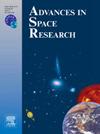Dynamics of EPBs and MSTIDs interaction during the post-midnight sector over the Indian low-latitude region
IF 2.8
3区 地球科学
Q2 ASTRONOMY & ASTROPHYSICS
引用次数: 0
Abstract
We present evidence of the merging of Equatorial Plasma Bubbles (EPBs) with Medium-Scale Travelling Ionospheric Disturbances (MSTIDs) during the post-midnight sector over the Indian region, observed on the night of 28th January 2011, a typical spread F event. The wavefront of the MSTIDs was aligned from northwest to southeast, propagating southwestward. In this study, we analyze airglow data from OI 630.0 nm emission recorded by an all-sky imager (ASI) located at Kolhapur (16.8°N, 74.2°E). The onset of EPBs was observed around 13:30 UT. Notably, eastward-moving EPBs began to merge with the dark wavefronts of MSTIDs around 19:50 UT, with the process completing by 21:45 UT. During this merging process, the drift velocity of EPBs decreased from 100 m/s to 50 m/s which later merged with the dark fronts of MSTIDs, as noted in OI 630.0 nm images. This interaction resulted in structural changes to the eastward drifting EPBs. The electrodynamics associated with this novel event is elaborated in this paper.
印度低纬度地区午夜后扇区epb和mstid相互作用的动态
我们提供了2011年1月28日夜间观测到的赤道等离子体气泡(EPBs)与中尺度电离层扰动(MSTIDs)在印度地区午夜后扇区合并的证据,这是一个典型的扩散F事件。mstid波前由西北向东南排列,向西南方向传播。在这项研究中,我们分析了位于Kolhapur(16.8°N, 74.2°E)的全天成像仪(ASI)记录的OI 630.0 nm发射的气辉数据。epb的发病时间约为世界时13:30。值得注意的是,东移的epb在19:50 UT左右开始与mstid的暗波前合并,到21:45 UT完成这一过程。在合并过程中,epb的漂移速度从100 m/s下降到50 m/s,随后与mstid的暗锋合并,如OI 630.0 nm图像所示。这种相互作用导致东移的强热带副热带气旋的结构变化。本文阐述了与这一新事件相关的电动力学。
本文章由计算机程序翻译,如有差异,请以英文原文为准。
求助全文
约1分钟内获得全文
求助全文
来源期刊

Advances in Space Research
地学天文-地球科学综合
CiteScore
5.20
自引率
11.50%
发文量
800
审稿时长
5.8 months
期刊介绍:
The COSPAR publication Advances in Space Research (ASR) is an open journal covering all areas of space research including: space studies of the Earth''s surface, meteorology, climate, the Earth-Moon system, planets and small bodies of the solar system, upper atmospheres, ionospheres and magnetospheres of the Earth and planets including reference atmospheres, space plasmas in the solar system, astrophysics from space, materials sciences in space, fundamental physics in space, space debris, space weather, Earth observations of space phenomena, etc.
NB: Please note that manuscripts related to life sciences as related to space are no more accepted for submission to Advances in Space Research. Such manuscripts should now be submitted to the new COSPAR Journal Life Sciences in Space Research (LSSR).
All submissions are reviewed by two scientists in the field. COSPAR is an interdisciplinary scientific organization concerned with the progress of space research on an international scale. Operating under the rules of ICSU, COSPAR ignores political considerations and considers all questions solely from the scientific viewpoint.
 求助内容:
求助内容: 应助结果提醒方式:
应助结果提醒方式:


